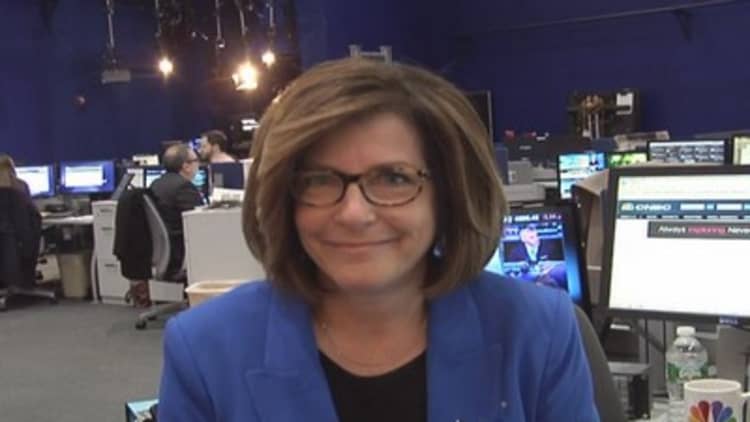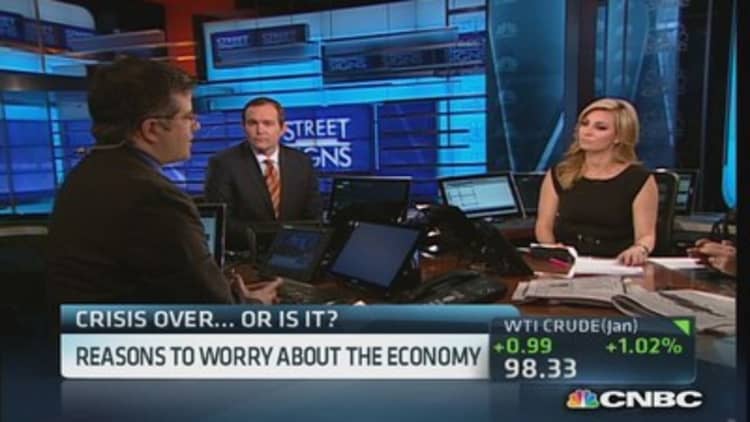The economy may finally have a clear runway for takeoff in 2014.
There are some clear signs of improvement. While still too high, the unemployment rate is now at a five-year low of 7 percent, and companies are hiring at an annual pace of 2.3 million. Consumers feel better about spending, buying big ticket items like cars, and mortgage debt rose in the third quarter for the first time since the first quarter of 2008. Auto sales in November soared to a surprise annualized selling rate of 16.4 million, the highest level since February 2007.
To be sure, there have been a series of fits and starts in the five years since the financial crisis, and there is still a mood of pessimism that the economy just can't click into gear and that growth will not achieve a velocity higher than a sluggish 2 percent.
"We've had some good excuses in the last few years with the European sovereign risk and fiscal drag. The European drag has faded, and the fiscal drag is set to fade," said Bruce Kasman, chief economist at JPMorgan. His forecast is that growth picks up in the coming year, reaching 3 percent by the second half and then staying at the higher pace for a while.

"I think if we don't get lift this year, if we can't get growth with a 2.83 10-year yield, and we're not seeing the benefits of fiscal drag fading, we're going to have to ask some very difficult questions about what's going on beneath the surface," Kasman said. "That's the central story. Obviously interest rates are part of the picture; behavior is part of the picture, and the global economy is part of the picture."
While economic data are still uneven, there is a checklist of positive developments that may help the economy or that at least represent progress and an opportunity for normalcy. The first event on that list is the Federal Reserve unwinding its bond-buying policy, potentially the most challenging event of the coming year.
The market's worst fears are that the economy is not strong enough to withstand the move higher in yields that is bound to come as the Fed slows its monthly purchases of the $85 billion in Treasury and mortgage securities. The Fed is also expected to manage rate expectations by talking down the short end of the curve with promises it will not raise the federal funds rate for a long time.
"I'm pretty confident lawmakers are going to fund the government. The biggest risk is 'can the Fed land the monetary plane on the tarmac? Can they manage to raise interest rates higher, consistent with the improvement in the job market?'" said Mark Zandi, chief economist at Moody's Analytics. "If they can't and rates jump, that's going to undermine housing, and that's the key to the recovery. I think if they can manage rates going forward ... we should be fine."
The Fed is expected to move toward slowing its quantitative easing bond purchases soon, possibly as early as next week, though many Fed watchers are expecting the first move to be in January or March. The Fed is expected to gradually reduce stimulus, and that would mean that it is confident in its forecast—that it sees an improving economy and better employment picture.

"I think the key issue in the outlook for 2014 isn't necessarily understanding the shift but whether they are going to be successful at it. They are trying to move the main tool of monetary policy away from purchases and on to promises," said BlackRock's Jeff Rosenberg, chief investment strategist for fixed income.
(Read more: Here it comes—the December taper)
Zandi expects growth of more than 3 percent in 2014. "All the preconditions for a much better economy are in place. It's just going to take a little spark and we'll be off and running, and I expect it this year. The only thing is -- I've been expecting it and that's the only thing that gets me nervous. I've been expecting it for a couple of years," he said.
"My sense is that the only thing that's been lacking, the only ingredient that's been missing is confidence, and that goes in part to the nightmare of the recession itself that's been weighing heavily on the collective psyche but legal and regulatory issues have also been weighing heavily," Zandi said.
Significant on the regulatory front was Tuesday's adoption of the Volcker Rule by federal agencies. The rule restricts proprietary trading by banks. "They can't run a casino inside the bank," said Michael Mayo, analyst with CLSA. However, he said there will be ways for bankers to get around the rule, but institutions have already made themselves less risk prone.
"I think the regulatory and legal uncertainty that has weighed heavily on the economy is lifting slowly but surely," said Zandi. He added that new mortgage rules defining what is an affordable mortgage and requiring originators to retain 5 percent of the security takes effect early next year.
Another symbolic event putting the crisis well in the rear view mirror was the government's exit from its stake in General Motors on Monday, signaling the auto industry is healthier and sales are gearing up.
"Other than employment, we've checked a lot of these boxes—even on the regulatory side. Financial regulation is getting some clarity, which has also helped, and after this week, we're not going to have a budget shutdown for at least two years," said Jospeh LaVorgna, chief U.S. economist at Deutsche Bank. LaVorgna expects to see a rate of growth above 3 percent next year.
Importantly, progress was made on the fiscal side in Washington this week, with Congressional leaders of both parties agreeing to a two-year budget that reduces cuts from the sequester that were planned for fiscal year 2014 and 2014. The hits to the economy from fiscal drag should be reduced and now modestly increase expectations for GDP growth in 2014. The deal also removes for a two-year period the chances of Congressional brinksmanship shutting down the government, as it did in October.
"There aren't any new tax hikes coming so that's a positive and the economy has adjusted to these tax hikes and ... because the economy is better, state and local spending is improving and they're hiring," said LaVorgna. He said at the same, the deficit, at the heart of the wrangling, has been shrinking.
The deficit of $680 billion in fiscal 2013 was well below the $1.1 trillion in fiscal 2012, he said. LaVorgna noted that the deficit is now equal to 4 percent of GDP and it had peaked in 2009 at 9.8 percent.
Other positive trends also stand to help the economy. U.S.energy production has been growing quickly, putting the U.S. near the top of world oil and gas producers. Goldman Sachs analysts last week forecast that U.S. shale production will keep U.S. energy prices lower than the rest of the world and that stronger U.S. growth will support Fed tapering.
As the Fed backs away from bond buying, the dollar should strengthen and emerging markets' currencies should get weaker. That would put downward pressure on emerging market oil demand. That should keep the U.S. well-supplied.Another change for the economy is the implementation of the Affordable Care Act, with new policies taking affect Jan. 1. While Kasman said it's hard to see just what the impact is, there has been a trend of deceleration in medical services prices. After decades of running higher than core inflation, the price increases of medical services are now below core inflation.
"It's been a big factor when you look at why core PCE has fallen," he said.
But whether the economy can withstand the Fed's move to normalcy is the big question for 2014.
Rosenberg, chief investment strategist for fixed income, sees the short end of the Treasury curve staying at current yield levels but he expects the 10-year yield to rise by a half percentage point next year. From its current level of roughly 2.85 percent, that would put the yield at 3.35 percent.
"What has supported the economy are three main things—interest rate sensitive spending; it's housing and it's wealth effect-induced spending," he said. "They're all highly dependent on easy financial market conditions." Rosenberg said there are limits to how high interest rates can go in an economy dependent on this type of growth.
There is debate over whether the motors for the economy can change in the coming year. "We're waiting to see business spending. We're waiting to see cap ex. We're waiting to see income growth. These are missing in the economy," Rosenberg said.
(Read more: Global economy might be comeback story of 2014)
While the economy has been recovering slowly, the stock market has raced ahead, with the S&P 500 gaining 26 percent so far this year.
"It's been five years now since the crisis so one would hope some progress was made on a number of issues. These concerns—from Europe to GM to the Volcker Rule—have not prevented stock markets around the world from rising so I would stop short of saying their removal is equally bullish. But there is little doubt that five years on, things are better and appear set to continue getting better," said Dan Greenhaus, chief global strategist at BTIG. —By CNBC's Patti Domm. Follow here on Twitter @pattidomm.





